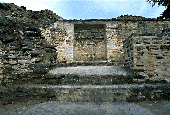|
Bordered by the Tigris and Euphrates rivers in the middle east is a fertile plain once known as Mesopotamia. The Ubaidian inhabitants of Sumer, otherwise known as the Sumerians, first settled in this region about 4,000 to 3,500 BC., in the city states of Ur, Babylon and Urak. Ur was one of the first settlements to be established in this area, and was located on the border of the al-Hajar Desert, just south of the Euphrates River. Ur became one of the most prosperous Sumerian city states. The city of Babylon became the religious and cultural center of the region.

  In Ur, numerous annual and monthly festivals were held, including a feast to celebrate the first sighting of the New Moon. To the Sumerians, the months began with the emergence of the New Moon in the heavens and ended with its disappearance at the next New Moon. The months were about 30 days long, with the first quarter occurring on the 7th, and the Full Moon on the 15th. This resulted in 12 months or moon cycles occurring each year, which resulted in a year of 354 days. They also divided the day into 12 periods, and further divided these periods into 30 parts, (4 minute increments).
In Ur, numerous annual and monthly festivals were held, including a feast to celebrate the first sighting of the New Moon. To the Sumerians, the months began with the emergence of the New Moon in the heavens and ended with its disappearance at the next New Moon. The months were about 30 days long, with the first quarter occurring on the 7th, and the Full Moon on the 15th. This resulted in 12 months or moon cycles occurring each year, which resulted in a year of 354 days. They also divided the day into 12 periods, and further divided these periods into 30 parts, (4 minute increments).

They erected four sided monuments called Obelisks to act like a sun-dial. By watching the moving shadows, they were able to mark off high noon as well as the solstices and equnioxes. These were built as early as 3500 B.C. They also erected large observatories or watch towers called "Ziggurats" in the temple complexes of the great cities to study celestial phenomena. (Ziggurats are monuments with stepped platforms ascending to a small temple or sanctuary at the peak.) The biblical Tower of Babel is said to be such a monument, called the temple-tower of Etemenanki.

In the city of Ur, in what is now present-day Iraq stands the Ziggurat of Nanna, a sort of temple or center of worship to the Sumerian Moon god Nanna and the Babylonian Moon god Sin. This Ziggurat was built around 2100 B.C. is the best preserved ruin of all the Ziggurats. You can still visit some of these ruins today (if there isn't a war on!).
 The Ziggurat of Ur-Nammu can be found here. The Ziggurat of Ur-Nammu can be found here.

Among the most ancient of monuments are the remains of giant stone structures or megalithic monuments erected by neolithic man in several areas of France and many regions throughout the world. There are about 900 megalithic circles concentrated in the British Isles. These megaliths are believed to be of Celtic origin, and range in height from 0,80 m to 22 m.
There are single standing stones or monoliths, stone circles (consisting of many monoliths,) such as Stonehenge in southern England, and perfectly aligned rows of monoliths. The best examples of these are located near the island town of Carnac.

Surrounding the island town of Carnac located in the Morbihan region of Brittany, are almost four thousand Megaliths arranged in a variety of configurations. These are the first megaliths and date from the Neolithic period, around 5,000 to 2,500 BC. There are long ranges of standing stones planted strategically into the ground in parallel alignments, called Menhirs. Some people have speculated that these stones served as astrological systems, Druid temples, calendars or ancient astronomical observatories and see a precise astronomical orientation in the alignments. There are also table-like arrangements, called dolmens, believed to be funeral monuments, with passageways linking the world of living with the world of the dead. Around Carnac are more than 100 dolmens and 4,000
menhirs.
 - In the city of Salisbury, located in southern England on the River Avon, is Stonehenge, the most famous of all megalithic monuments. These megaliths were built in three periods, beginning about 2800 BC, and consist of four concentric ranges of stones.
Various archaeologists and astronomers claim that Stonehenge was used to predict eclipses of the Sun and Moon, and that the people of this region also observed the Moon’s horizon cycle, as well as the Sun’s, including the measurement of solstices and celestial phenomena, such as the lunar eclipses.

In 1964, Gerald Hawkins, a Professor of the Astronomy department at Boston University subjected the Stonehenge site to numerous tests and concluded that the Stonehenge architecture is a very sophisticated system. He suggests that by the very nature of its design, Stonehenge acts as sort of a neolithic computer. He has also suggested that the solar and stellar alignments of Stonehenge were used to predict eclipses of the Sun and Moon, and that the Stonehenge astronomers were also counting off eclipse "seasons" which recur about every six months as well. The site's axis points roughly in the direction of the sunrise at the summer solstice.

|












